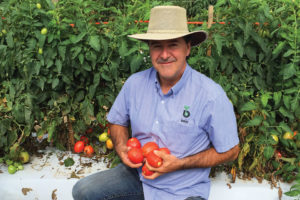Two Plant Breeders Reflect on Building Disease Resistance into New Varieites
Smart breeders not only build in resistance to current diseases, they look at which diseases are on the rise in other parts of the world. Here are two breeders who are doing just that:
 Doug Heath, Bejo Seeds
Doug Heath, Bejo Seeds
Crop: Tomato
Heath, Bejo Seeds’ Senior Tomato Breeder, is always trying to increase disease resistance while simultaneously trying to elevate taste and color.
“I am adding several virus resistances [tomato spotted wilt and tomato yellow leaf curl], as well as several new strategies for nematode resistance and resistance to several Fusarium species,” Heath says. “I am working closely with my molecular marker specialist in Holland and we are targeting, in some cases, selections that have a smaller fragment of the introduced DNA that contains the resistance gene of interest, but as little of the additional DNA as possible.”
He thinks some exciting breakthroughs will come during the next five years.
“Stay tuned!” he says.
 Nihat Guner, Sakata Seed America
Nihat Guner, Sakata Seed America
Crop: Watermelon
Guner says the No. 1 goal of all breeding programs is to increase growers’ profit through increased yield. Naturally, that means disease resistance is a high priority, since disease can significantly decrease yield.
“In Sakata’s global watermelon breeding program, we have been integrating traits such as current core disease resistances along with future upcoming diseases that could be destructive to the watermelon industry. Other traits we seek are early maturity, longer field and shelf life, and superior pollenizer, which will contribute to get higher yield in triploids.
“Disease resistance in watermelon is important factor due to its negative effect on crop yield, loss, and lowering the fruit quality. Fusarium wilt and anthracnose are core diseases for watermelon. In recent years, Fusarium race 2 resistance is becoming more and more prevalent in the U.S., and rootstock usage is getting popular.
“Powdery mildew, gummy stem blight, and virus resistances are also important diseases in certain environmental conditions. After methyl bromide was phased out, new fumigants are not as effective as methyl bromide especially on controlling nematodes. Therefore, genetic nematode resistance is becoming an essential as well.”









